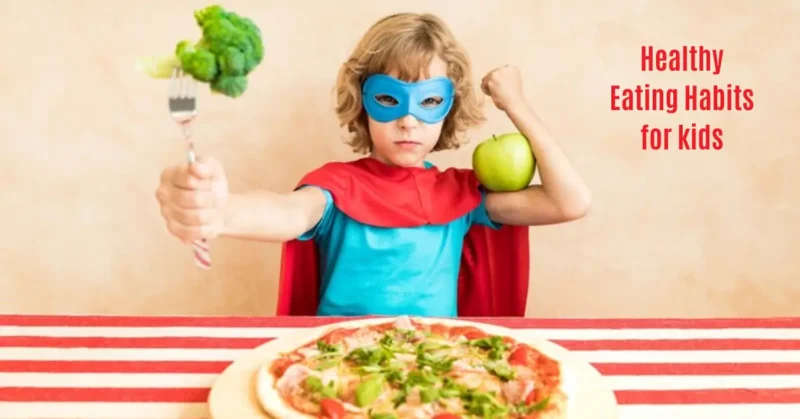Learn practical tips and tricks for developing healthy eating habits in kids. Learn how to balance nutrition, make mealtime fun, and encourage a lifelong love of nutritious foods. Perfect for parents looking to improve their children’s diet and overall well-being.
How to Get Started
Healthy eating is crucial for kids, laying the foundation for their growth, development, and overall well-being. But as every parent knows, getting kids to eat healthily can be challenging. This article will provide practical tips and tricks to help your kids develop healthy eating habits that will benefit them for life.
Healthy eating habits and tips

These tips can prepare your children for a healthy future and a positive relationship with food.
Understanding Nutrition Needs
Understanding children’s fundamental nutritional needs is vital for their growth and development. Children require diverse nutrients, such as essential vitamins, minerals, proteins, carbohydrates, and fats, to ensure healthy development. The needs can vary based on age, gender, and activity level. For instance, toddlers require more fats for brain development, while older kids need more proteins for muscle growth.
Incorporating Fruits and Vegetables
Vegetables and fruits are a great source of fiber, vitamins, and minerals. They are crucial in averting chronic illnesses and preserving general health. However, it can be challenging to get kids to eat them. Add fruits to their favorite cereals or smoothies, and include vegetables in fun shapes or mixed into sauces. The key is to make these healthy options appealing and accessible.
Healthy Snacking
Snacks can be both nutritious and delicious. Healthy snacks provide the energy kids need between meals and prevent overeating at mealtime. Some great snack ideas include sliced fruits, yogurt, whole-grain crackers with cheese, and veggie sticks with hummuIt’st’s all about finding a balance that satisfies their hunger and nutritional needs.
Balancing Macronutrients
A clear understanding of carbohydrates, proteins, and fats is essential. A person’s body requires carbohydrates for energy, proteins for growth, and fats for brain development. Balanced diets include foods from each macronutrient group. For instance, you can combine whole grains with lean proteins and healthy fats such as nuts or avocados.
Hydration is Key
Water is vital for every body cell, especially for active kids. Dehydration can lead to fatigue and concentration problems. Encourage your children to drink water by making it fun—use colorful bottles, add fruit slices for flavor, or set up a reward system for meeting daily hydration goals.
Limiting Sugary Drinks and Snacks
Too much use of sugar can cause tooth damage and obesity, among other health problems. Lessen your intake of sugary drinks such as sodas or fruit juices and replace them with milk, water, or diluted natural juices. Regarding snacks, choose options like fruits, nuts, or whole-grain products instead of sugary treats.
Establishing Regular Meal Times
Kids thrive on routine, and having regular meal times helps them understand the importance of structured eating. Try to eat two healthy snacks and three well-balanced meals per day. A regular meal schedule will help you avoid overindulging in snacks and keep your energy levels stable throughout the day.
Making Meals Fun and Engaging
How food is presented can significantly impact whether or not youngsters consume it. Use cookie cutters to cut out entertaining shapes, bright plates filled with delicacies, or meal themes. Involving kids in meal preparation can also increase their interest in what they eat.
Understanding Portion Sizes for Healthy Eating
Appropriate portion sizes are crucial to prevent overeating. Teach your kids about portion control by serving food on smaller plates and bowls. Remember, children’s stomachs are smaller, so they don’t need as much food as adults. Please remind them to pay attention to their bodies and stop eating when they are full, not overfed.
Dealing with Picky Eaters
Many kids go through phases of picky eating. The trick is to remain patient and persistent. Slowly and in tiny portions, introduce new meals alongside well-known favorites. Encourage tasting without pressure, and praise their efforts when they try something new, even if theyn’tn’t like it immediately.
Encouraging Family Meals
Eating together as a family has numerous benefits. It allows one to model healthy eating habits, fosters better communication, and strengthens family bonds. Make family meals a priority and use this time to enjoy each other’s company without distractions like TV or phones.
Teaching Mindful Eating
Mindful eating involves:
- Paying attention to the eating experience.
- Appreciating the scent, taste, and texture of food.
- Recognizing hunger and fullness cues.
Encourage your kids to eat slowly and savor their food. This practice can help prevent overeating and develop a healthier relationship with food.
Role of Physical Activity
A healthy diet goes hand in hand with physical activity. Regular exercise helps maintain a healthy weight, improve mood, and support overall health. Encourage your kids to stay active through sports, play, or family activities like biking or hiking. Make it fun, and they’ll likely stick with it.
FAQs on Healthy Eating
Q. What are seven healthy eating tips?
- Balance Your Plate: Include vegetables, fruits, proteins, and whole grains in every meal.
- Watch Portion Sizes: Serve age-appropriate portions to prevent overeating and teach kids to listen to their hunger cues.
- Limit Sugar and Salt: Reduce the amount of added sugar and salt in your child’s diet by choosing fresh, whole foods.
- Encourage Breakfast: Start the day with a nutritious breakfast to fuel their morning activities.
- Make Fruits and Veggies Fun: Use creative ways to include more fruits and vegetables, such as fun shapes or colorful presentations.
- Healthy Snacking: Choose snacks that provide nutrients and energy, like nuts, seeds, and yogurt.
- Stay Hydrated: Promote drinking water over sugary drinks to keep your kids hydrated and healthy.
Q. How do you teach kids healthy food?
- Lead by example: Eat healthy foods yourself to set a good example for your kids.
- Get Them Involved: To increase their interest in healthy foods, let your kids help with meal planning, grocery shopping, and cooking.
- Education: Teach them about different food groups and the benefits of each type of food.
- Make it Fun: Create fun and engaging activities related to healthy eating, like food-themed games or cooking competitions.
- Consistency: Regularly offer a variety of healthy foods and encourage tasting without pressure.
Q. What are five healthy eating habits for kids?
- Eat a Variety of Foods: Encourage your kids to try different foods from all food groups, ensuring they get a balanced diet with essential nutrients.
- Regular Meal Times: Establish consistent meal and snack times to help regulate their metabolism and avoid unnecessary snacking.
- Healthy Snacking: Provide nutritious snack options like fruits, nuts, yogurt, and whole grains instead of sugary or processed snacks.
- Stay Hydrated: Ensure your kids drink plenty of water throughout the day. Avoid sugary drinks and sodas.
- Eat Together as a Family: Family meals encourage healthier eating habits and allow one to model good eating behavior.
Q. What are the five tips for making healthy food choices?
- Plan: Plan meals and snacks to ensure you always have healthy options.
- Read Labels: Check nutrition labels to choose products with lower sugar, salt, and unhealthy fats.
- Shop the Perimeter: Focus on the outer aisles of the grocery store where fresh produce, dairy, and meats are typically located.
- Cook at Home: Prepare meals at home to control ingredients and avoid processed foods.
- Avoid Sugary Drinks: Choose water, milk, or natural juices over sodas and sugary drinks.
Q. What are ten healthy eating tips?
- Eat a Rainbow: Incorporate a variety of colorful fruits and vegetables into your meals.
- Whole Grains: Choose whole grains over refined grains for added fiber and nutrients.
- Protein Variety: Include different protein sources, such as lean meats, beans, and nuts.
- Healthy Fats: Opt for healthy fats like avocados, nuts, and olive oil instead of saturated and trans fats.
- Control Portions: Be mindful of portion sizes to avoid overeating.
- Limit Processed Foods: Reduce consumption of processed and junk foods.
- Hydrate: Drink plenty of water throughout the day.
- Regular Meals: Stick to a regular meal schedule to maintain energy levels.
- Healthy Snacks: Choose nutritious snacks to keep hunger at bay between meals.
- Cook Together: Involve the whole family in cooking to make healthy eating a fun and collaborative activity.
Q. What are five healthy tips?
- Stay Active: Encourage regular physical activity to complement a healthy diet.
- Get Enough Sleep: Ensure your kids get adequate sleep to support their health.
- Reduce Screen Time: Limit screen time to encourage more physical and creative activities.
- Practice Mindfulness: Teach mindful eating habits to help your kids listen to their hunger and fullness cues.
- Stay Positive: Focus on the positive aspects of healthy eating and create a supportive environment around food choices.
Conclusion on Healthy Eating
Helping your kids develop healthy eating habits is one of the best gifts you can give them. It sets the stage for a lifetime of good health and well-being. Remember to make small, consistent changes and be a positive role model. Start incorporating these tips and tricks today, and watch your children thrive.
Read more articles about Health & Wellness.
You might like to read:
How Moms Can Foster a Healthy Home: Practical Tips and Insights

